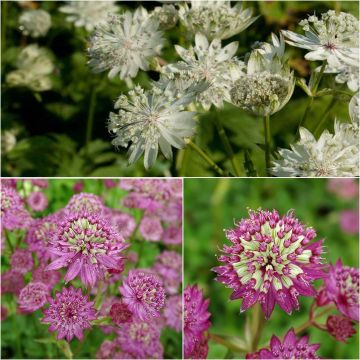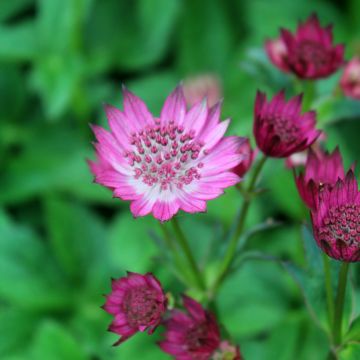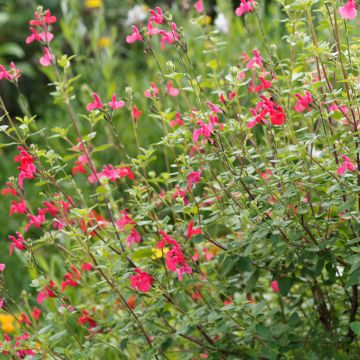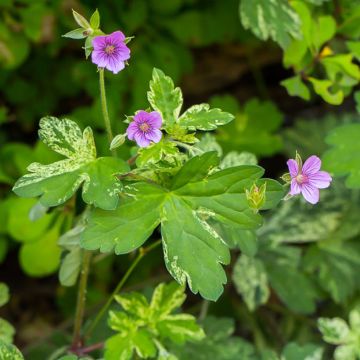

Astrantia major Cerise Button - Masterwort
Astrantia major Cerise Button - Masterwort
Astrantia major Cerise Button
Masterwort
Very puny, struggling to recover. Did not flower this year.
Zoe, 09/11/2025
Special offer!
Receive a €20 voucher for any order over €90 (excluding delivery costs, credit notes, and plastic-free options)!
1- Add your favorite plants to your cart.
2- Once you have reached €90, confirm your order (you can even choose the delivery date!).
3- As soon as your order is shipped, you will receive an email containing your voucher code, valid for 3 months (90 days).
Your voucher is unique and can only be used once, for any order with a minimum value of €20, excluding delivery costs.
Can be combined with other current offers, non-divisible and non-refundable.
Home or relay delivery (depending on size and destination)
Schedule delivery date,
and select date in basket
This plant carries a 12 months recovery warranty
More information
We guarantee the quality of our plants for a full growing cycle, and will replace at our expense any plant that fails to recover under normal climatic and planting conditions.

Would this plant suit my garden?
Set up your Plantfit profile →
Description
Astrantia major 'Cerise Button' is a recent variety of masterwort with a beautifully coloured and long-lasting flowering. Its flowers in shades of raspberry pink to cherry red resemble those of Astrantia Washfield, but these flowers are much more vigorous and floriferous. The vibrant colours give the flowers the appearance of jewellery set with gemstones. Astrantia major is a perennial accustomed to cottage gardens, it is a native plant that thrives in slightly neglected, shady and cool places. It is also a good flower for dry or fresh bouquets.
Astrantia major, native to central and eastern Europe, belongs to the Apiaceae family (formerly Umbellifers), it is a distant relative of the carrot. This plant is the origin of many cultivars and hybrids, including the 'Cerise Button' variety, selected by Marco Van Noort in the Netherlands. In this variety, the bushy and dense habit displays elegant and abundant flowers. The plant forms a clump 60-65 cm (24-26in) high when in flower, 45-50 cm (18-20in) for the foliage, and 45 cm (18in) wide. The foliage is composed of deciduous, palmate leaves with 5 deep lobes, lanceolate, toothed, green and strongly veined. The umbel flowers appear from June to August-September, at the end of very stiff stems. They are composed of dozens of tiny flowers in a deep raspberry pink, surrounded by large pearly bracts with cherry red reflections.
Astrantia major 'Cerise Button' grows in humus-rich, moist and well-drained soil, in sunny but not scorching or semi-shaded, even shady in warm climates. This plant, very popular in contemporary gardens, requires little maintenance, thriving even where the garden is not well-maintained. It blends beautifully with the pastel colours of foxgloves, columbines, lungworts... Combine it with perennials and roses in any style of garden: modern, natural or romantic.
Tips: Combine several varieties to create a beautiful colour palette.
Report an error about the product description
Astrantia major Cerise Button - Masterwort in pictures




Flowering
Foliage
Plant habit
Botanical data
Astrantia
major
Cerise Button
Apiaceae
Masterwort
Cultivar or hybrid
Other Astrantia - Masterwort
View all →Planting and care
Astrantia major Cerise Button grows in humus-rich, well-drained but not dry soil, in sunny, partially shaded or even shady positions in warm climates. It requires little maintenance. Prune the unsightly foliage before winter and remove faded flowers to promote a new flowering. It self-seeds very easily. Its only known enemies are slugs and snails.
To plant your young plant, prepare your soil to a depth of 20 cm (8in) by breaking up the soil well and adding fertiliser such as bone meal. Position your plant, removed from its pot, by covering the top of the root ball with 3 cm (1in) of soil. Fill in the hole, tamp down, and water thoroughly to eliminate any air pockets. During dry weather, water regularly for a few weeks to facilitate root establishment. During wet weather, it is necessary to protect the young plants from slugs by using wood ash, slug repellent, or even beer! Each of these solutions is highly effective.
Planting period
Intended location
Care
-
, onOrder confirmed
Reply from on Promesse de fleurs
Similar products
Haven't found what you were looking for?
Hardiness is the lowest winter temperature a plant can endure without suffering serious damage or even dying. However, hardiness is affected by location (a sheltered area, such as a patio), protection (winter cover) and soil type (hardiness is improved by well-drained soil).

Photo Sharing Terms & Conditions
In order to encourage gardeners to interact and share their experiences, Promesse de fleurs offers various media enabling content to be uploaded onto its Site - in particular via the ‘Photo sharing’ module.
The User agrees to refrain from:
- Posting any content that is illegal, prejudicial, insulting, racist, inciteful to hatred, revisionist, contrary to public decency, that infringes on privacy or on the privacy rights of third parties, in particular the publicity rights of persons and goods, intellectual property rights, or the right to privacy.
- Submitting content on behalf of a third party;
- Impersonate the identity of a third party and/or publish any personal information about a third party;
In general, the User undertakes to refrain from any unethical behaviour.
All Content (in particular text, comments, files, images, photos, videos, creative works, etc.), which may be subject to property or intellectual property rights, image or other private rights, shall remain the property of the User, subject to the limited rights granted by the terms of the licence granted by Promesse de fleurs as stated below. Users are at liberty to publish or not to publish such Content on the Site, notably via the ‘Photo Sharing’ facility, and accept that this Content shall be made public and freely accessible, notably on the Internet.
Users further acknowledge, undertake to have ,and guarantee that they hold all necessary rights and permissions to publish such material on the Site, in particular with regard to the legislation in force pertaining to any privacy, property, intellectual property, image, or contractual rights, or rights of any other nature. By publishing such Content on the Site, Users acknowledge accepting full liability as publishers of the Content within the meaning of the law, and grant Promesse de fleurs, free of charge, an inclusive, worldwide licence for the said Content for the entire duration of its publication, including all reproduction, representation, up/downloading, displaying, performing, transmission, and storage rights.
Users also grant permission for their name to be linked to the Content and accept that this link may not always be made available.
By engaging in posting material, Users consent to their Content becoming automatically accessible on the Internet, in particular on other sites and/or blogs and/or web pages of the Promesse de fleurs site, including in particular social pages and the Promesse de fleurs catalogue.
Users may secure the removal of entrusted content free of charge by issuing a simple request via our contact form.
The flowering period indicated on our website applies to countries and regions located in USDA zone 8 (France, the United Kingdom, Ireland, the Netherlands, etc.)
It will vary according to where you live:
- In zones 9 to 10 (Italy, Spain, Greece, etc.), flowering will occur about 2 to 4 weeks earlier.
- In zones 6 to 7 (Germany, Poland, Slovenia, and lower mountainous regions), flowering will be delayed by 2 to 3 weeks.
- In zone 5 (Central Europe, Scandinavia), blooming will be delayed by 3 to 5 weeks.
In temperate climates, pruning of spring-flowering shrubs (forsythia, spireas, etc.) should be done just after flowering.
Pruning of summer-flowering shrubs (Indian Lilac, Perovskia, etc.) can be done in winter or spring.
In cold regions as well as with frost-sensitive plants, avoid pruning too early when severe frosts may still occur.
The planting period indicated on our website applies to countries and regions located in USDA zone 8 (France, United Kingdom, Ireland, Netherlands).
It will vary according to where you live:
- In Mediterranean zones (Marseille, Madrid, Milan, etc.), autumn and winter are the best planting periods.
- In continental zones (Strasbourg, Munich, Vienna, etc.), delay planting by 2 to 3 weeks in spring and bring it forward by 2 to 4 weeks in autumn.
- In mountainous regions (the Alps, Pyrenees, Carpathians, etc.), it is best to plant in late spring (May-June) or late summer (August-September).
The harvesting period indicated on our website applies to countries and regions in USDA zone 8 (France, England, Ireland, the Netherlands).
In colder areas (Scandinavia, Poland, Austria...) fruit and vegetable harvests are likely to be delayed by 3-4 weeks.
In warmer areas (Italy, Spain, Greece, etc.), harvesting will probably take place earlier, depending on weather conditions.
The sowing periods indicated on our website apply to countries and regions within USDA Zone 8 (France, UK, Ireland, Netherlands).
In colder areas (Scandinavia, Poland, Austria...), delay any outdoor sowing by 3-4 weeks, or sow under glass.
In warmer climes (Italy, Spain, Greece, etc.), bring outdoor sowing forward by a few weeks.



















































